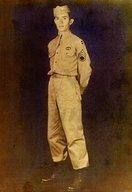
|

|
|
|
|
Albert was born in Port Allen, Louisiana, as the youngest of six children of Lewis Edward Austin and Amanda Leah Dyer Austin. When he was a year old the family moved to Baton Rouge. His mother passed away when he was five. His father, who worked as a kerosene truck driver for Standard Oil Company of Louisiana, later married Jessie Spillman, whom Albert and his siblings called "Aunt Jessie". The family was fortunate, he recalls, that his father kept his job throughout the Depression. "It wasn't much of a salary, but it was enough," he remarks. Albert also contributed to his upkeep and the family income. He was working in a grocery store by age 13, and sold snacks at LSU football games. Albert attended Baton Rouge High School until he quit in the tenth grade to enter the U.S. Army on January 9, 1941. "Wasn't much going on. Didn't have that many jobs available," he recalls as his reason to enlist. Albert, who enlisted for one year, took 13 weeks of basic training at Camp Claiborne. He was sent to Fort Sam Houston in San Antonio, where he completed medical technician school and was assigned to a hospital in surgery at Camp Claiborne. He was in his bunk on December 7, 1941 when the Japanese attacked Pearl Harbor. "Hardly no response," he said of the men around him. "Nobody got excited about it. Didn't realize the scope of what this is all about. We were all just young kids." His one-year enlistment was up on January 9, 1942, but after Pearl Harbor he was put on "indefinite enlistment". On January 4, 1943 he married Peggy Joyce DeHart. (They would have three children.) Albert joined the paratroopers and was sent to jump school at Fort Benning near Columbus, Georgia. By that time his rank was T4, the equivalent of a buck sergeant. In joining the paratroopers he had to take a cut in rank to private, but his pay increased to $50 a month. In addition he received $50 in "jump pay". After finishing jump school he was assigned to the 513th Parachute Infantry Regiment, a replacement regiment for units in combat. He was placed in charge of the regimental aid station and promoted to staff sergeant. He was on the west coast training for the invasion of Japan when the war ended. Albert left the service in December of 1945, and returned to Baton Rouge, where he worked as a grocery store clerk and at King's Laundry. Meanwhile he earned a GED high school diploma. Albert re-enlisted in December of 1949 at his old rank of staff sergeant. He was sent to Korea in June of 1950 as non-commissioned officer in charge (NCOIC) of the battalion aid station of 3rd Battalion, 7th Cavalry Regiment, 1st Cavalry Division. Albert's aid station was "anywhere from 150 to 200 yards" from the front lines. He was in the breakout from the Pusan Perimeter, in which allied forces pushed the enemy back until reaching Osan, about 108 miles northwest. He received a Bronze Star with a V device for his service. He recalls taking Pyongyang, North Korea, then going up 15 miles of the Yalu River in a task force of a platoon of tanks, a battery of field artillery, and a battalion of infantry. Once, he was on line for 40 days without relief. Albert completed his service in Korea and sailed to Seattle as part of the first group of Korean veterans to return to the States. "They had a wonderful welcome for us. They had at least five boats out in the ocean and surrounded the ship with the hoses going, the bands playing," he recalls. Albert was stationed at Fort Sill in Lawton, Oklahoma where he contracted malaria after exposure in Korea. After recovery, he was stationed for three years in Germany, first at Bogner Oberstoff, then in Munich and finally at Tegernsee. Back in America he served at Fort Stewart near Hinesville, Georgia, then was in France for 16 months. Earlier he had served another tour in Korea in 1963 in headquarters of 1st Cavalry Division as part of preventive medicine. Retiring from the army in 1966, Albert worked for United States Public Health in Shreveport, where he coordinated a school vaccination program. He retired from that position in 1983 |


